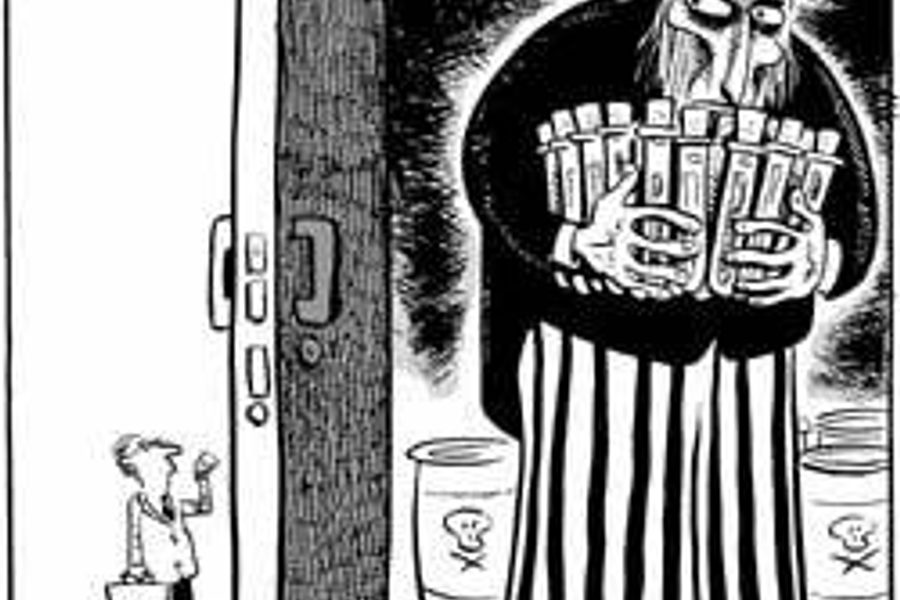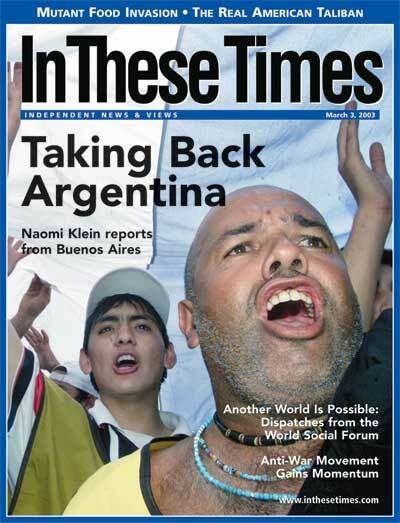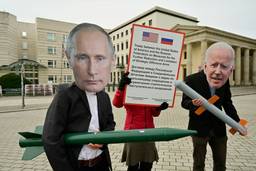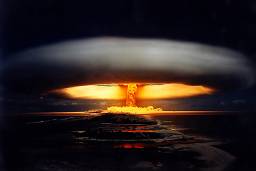
As the controversy rages on over how long the United Nations should continue weapons inspections in Iraq, questions are being raised about the United States’ own stockpile of chemical and biological weapons and new clandestine weapons programs. Activists and scientists are calling for weapons inspections in the United States.
On September 4, 2001, the New York Times printed a front-page article under the headline, “U.S. Germ Warfare Research Pushes Treaty Limits.” While the story got lost in the events of September 11, the article revealed that the United States had initiated a secret weapons program that could be in violation of the Biological Weapons Convention, the landmark 1972 treaty that prohibits the development, production and stockpiling of biological agents that have no “prophylactic, protective or other peace purpose.” Signers of the treaty pledged not to develop or obtain weapons “designed to use such agents or toxins for hostile purposes or in armed conflict.”
The article’s revelations shed light on why the United States, which had been the driving force behind the treaty since announcing its intention to unilaterally dismantle biological weapons stocks during the Nixon administration, rejected a July 2001 protocol that would have provided for regular inspections to verify compliance with the treaty. The Bush administration’s rejection of the protocol left the treaty dead in the water.
During the Clinton administration, the United States initiated classified biodefense programs within the Energy and Defense departments and the Central Intelligence Agency. The CIA built and tested a cluster bomb that could spread biological agents over a wide area. The Pentagon’s Threat Reduction Agency built a bioweapons plant from commercially available materials in the Nevada desert to demonstrate the ease with which such a project could be undertaken by terrorists or rogue states without raising suspicions. The Defense Intelligence Agency tried to genetically engineer more powerful anthrax to replicate a Russian strain thought to be resistant to U.S. military vaccinations.
The United States maintains that these programs are defensive, claiming that in order to manufacture vaccines and develop defenses against biological attacks, researchers must first be able to produce the weapons. In the words of one official, the projects are “fully consistent with the treaty.”
But Mark Wheelis and Malcolm Dando, authors of “Back to Bioweapons,” an article in the January/February issue of The Bulletin of the Atomic Scientists, warn that the implications of this decision are far-reaching and dangerous. “U.S. behavior suggests that its biodefense program is even larger than those portions that have been revealed,” they write. “This U.S. exploration of the utility of biotech for bioweapons development is unwise, for the rest of the world will be obliged to follow suit,” creating the conditions for a “global bioweapons arms race.”
Quite a few facilities around the country are doing research on chemical and biological weapons. Among them are the U.S. Army Medical Research Institute for Infectious Diseases at Fort Detrick, Maryland; the U.S. Army Dugway Proving Ground in Utah; the U.S. Department of Agriculture Plum Island Animal Disease Center in New York; and the Battelle Memorial Institute in Columbus, Ohio. The New York Times named Battelle, a military contractor that analyzes biological information for the Pentagon, as a participant in the CIA’s secret effort to make a more potent anthrax.
While the activities of most of these facilities are shrouded from public knowledge, a small Canadian effort hopes to expose them. The project, called “Rooting out Evil,” is planning inspections of U.S. chemical, biological and nuclear sites like the ones listed above. In February, the inspection team, including Canadian and British members of parliament, a union leader and a professor, will enter the United States and demand “immediate and unfettered access” to chemical, biological and nuclear weapons sites.
Citizen weapons inspections have a long tradition. Most recently, three Catholic nuns entered an N-8 missile silo in northern Colorado wearing white jumpsuits with the logo “Disarmament Specialists” stenciled on the front, and “CWIT” (Citizen Weapons Inspection Team) written on the back. They occupied the site for several hours, dismantling the tracks that carry the silo lid to its firing position with hammers. They poured their own blood on the tracks and the silo. Despite the prayerful and symbolic nature of their action, they were charged with sabotage and “injury to property” and are facing a maximum sentence of 30 years.
Activists calling for and carrying out inspections of U.S. sites are finding allies within the scientific community. Jonathan King, an MIT biologist, says the United States should welcome inspectors into chemical and biological weapons programs. Scientists at the country’s top universities are signing petitions and drafting codes of ethics for work in this field; some have even outlined a new biological weapons treaty that would make violations a crime under international law. As Harvard biologist Matthew Meselson, once a close adviser to Henry Kissinger, recently told the Boston Globe, bioweapons are a “threat to the species. It rises above considerations of national security, important as they may be.”
Maybe once the U.N. inspectors are finished in Iraq, they can turn their attention to the United States. It seems they would be guaranteed abundant work and generous support from activists and scientists alike.
On September 4, 2001, the New York Times printed a front-page article under the headline, “U.S. Germ Warfare Research Pushes Treaty Limits.” While the story got lost in the events of September 11, the article revealed that the United States had initiated a secret weapons program that could be in violation of the Biological Weapons Convention, the landmark 1972 treaty that prohibits the development, production and stockpiling of biological agents that have no “prophylactic, protective or other peace purpose.” Signers of the treaty pledged not to develop or obtain weapons “designed to use such agents or toxins for hostile purposes or in armed conflict.”
The article’s revelations shed light on why the United States, which had been the driving force behind the treaty since announcing its intention to unilaterally dismantle biological weapons stocks during the Nixon administration, rejected a July 2001 protocol that would have provided for regular inspections to verify compliance with the treaty. The Bush administration’s rejection of the protocol left the treaty dead in the water.
During the Clinton administration, the United States initiated classified biodefense programs within the Energy and Defense departments and the Central Intelligence Agency. The CIA built and tested a cluster bomb that could spread biological agents over a wide area. The Pentagon’s Threat Reduction Agency built a bioweapons plant from commercially available materials in the Nevada desert to demonstrate the ease with which such a project could be undertaken by terrorists or rogue states without raising suspicions. The Defense Intelligence Agency tried to genetically engineer more powerful anthrax to replicate a Russian strain thought to be resistant to U.S. military vaccinations.
The United States maintains that these programs are defensive, claiming that in order to manufacture vaccines and develop defenses against biological attacks, researchers must first be able to produce the weapons. In the words of one official, the projects are “fully consistent with the treaty.”
But Mark Wheelis and Malcolm Dando, authors of “Back to Bioweapons,” an article in the January/February issue of The Bulletin of the Atomic Scientists, warn that the implications of this decision are far-reaching and dangerous. “U.S. behavior suggests that its biodefense program is even larger than those portions that have been revealed,” they write. “This U.S. exploration of the utility of biotech for bioweapons development is unwise, for the rest of the world will be obliged to follow suit,” creating the conditions for a “global bioweapons arms race.”
Quite a few facilities around the country are doing research on chemical and biological weapons. Among them are the U.S. Army Medical Research Institute for Infectious Diseases at Fort Detrick, Maryland; the U.S. Army Dugway Proving Ground in Utah; the U.S. Department of Agriculture Plum Island Animal Disease Center in New York; and the Battelle Memorial Institute in Columbus, Ohio. The New York Times named Battelle, a military contractor that analyzes biological information for the Pentagon, as a participant in the CIA’s secret effort to make a more potent anthrax.
While the activities of most of these facilities are shrouded from public knowledge, a small Canadian effort hopes to expose them. The project, called “Rooting out Evil,” is planning inspections of U.S. chemical, biological and nuclear sites like the ones listed above. In February, the inspection team, including Canadian and British members of parliament, a union leader and a professor, will enter the United States and demand “immediate and unfettered access” to chemical, biological and nuclear weapons sites.
Citizen weapons inspections have a long tradition. Most recently, three Catholic nuns entered an N-8 missile silo in northern Colorado wearing white jumpsuits with the logo “Disarmament Specialists” stenciled on the front, and “CWIT” (Citizen Weapons Inspection Team) written on the back. They occupied the site for several hours, dismantling the tracks that carry the silo lid to its firing position with hammers. They poured their own blood on the tracks and the silo. Despite the prayerful and symbolic nature of their action, they were charged with sabotage and “injury to property” and are facing a maximum sentence of 30 years.
Activists calling for and carrying out inspections of U.S. sites are finding allies within the scientific community. Jonathan King, an MIT biologist, says the United States should welcome inspectors into chemical and biological weapons programs. Scientists at the country’s top universities are signing petitions and drafting codes of ethics for work in this field; some have even outlined a new biological weapons treaty that would make violations a crime under international law. As Harvard biologist Matthew Meselson, once a close adviser to Henry Kissinger, recently told the Boston Globe, bioweapons are a “threat to the species. It rises above considerations of national security, important as they may be.”
Maybe once the U.N. inspectors are finished in Iraq, they can turn their attention to the United States. It seems they would be guaranteed abundant work and generous support from activists and scientists alike.
Frida Berrigan writes for TomDispatch, Waging Nonviolence and other outlets. Her book, It Runs in the Family: On Being Raised By Radicals and Growing Into Rebellious Motherhood, was published by OR Books in 2015. She lives in New London, Conn., with her husband, three kids and six chickens.









